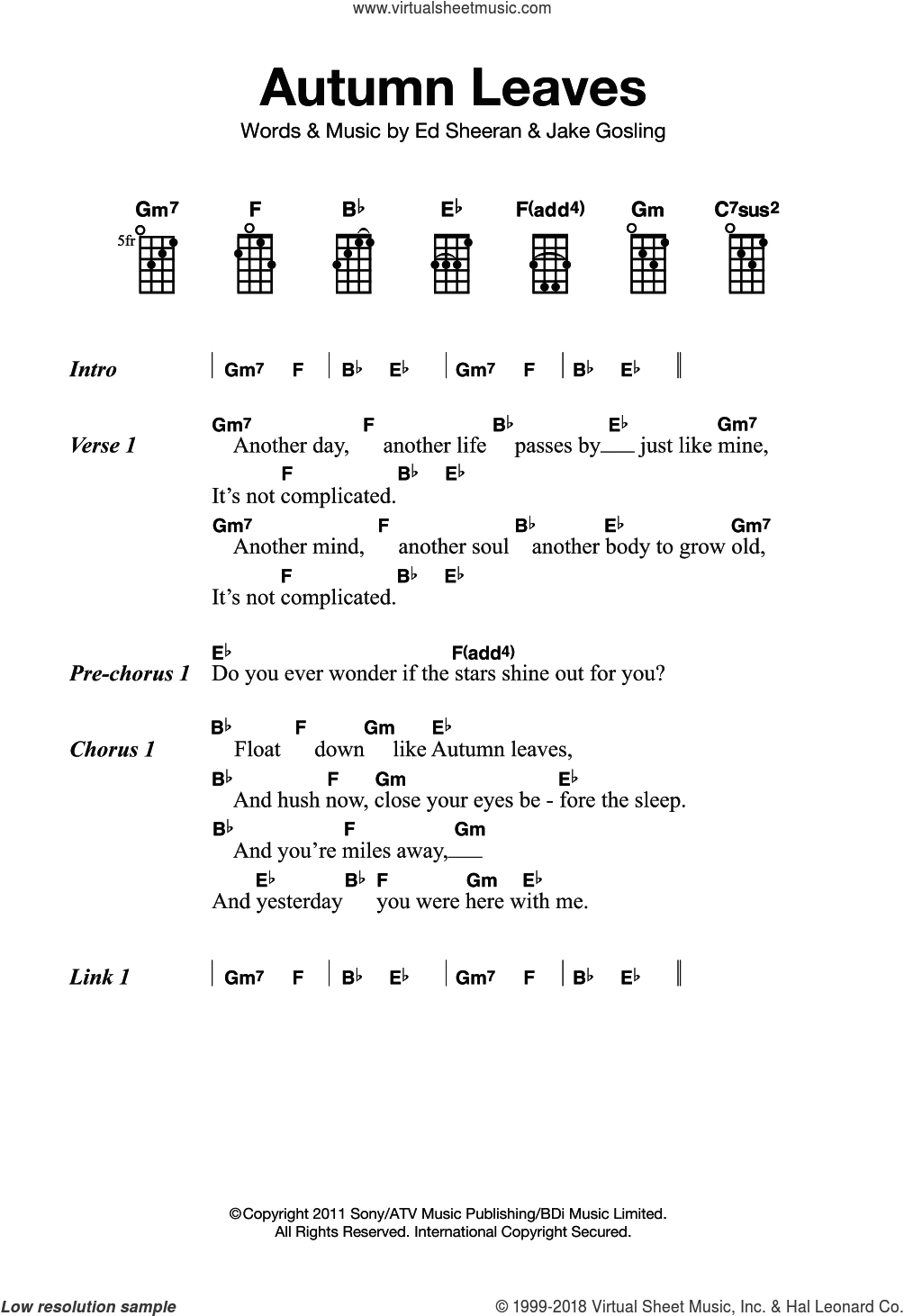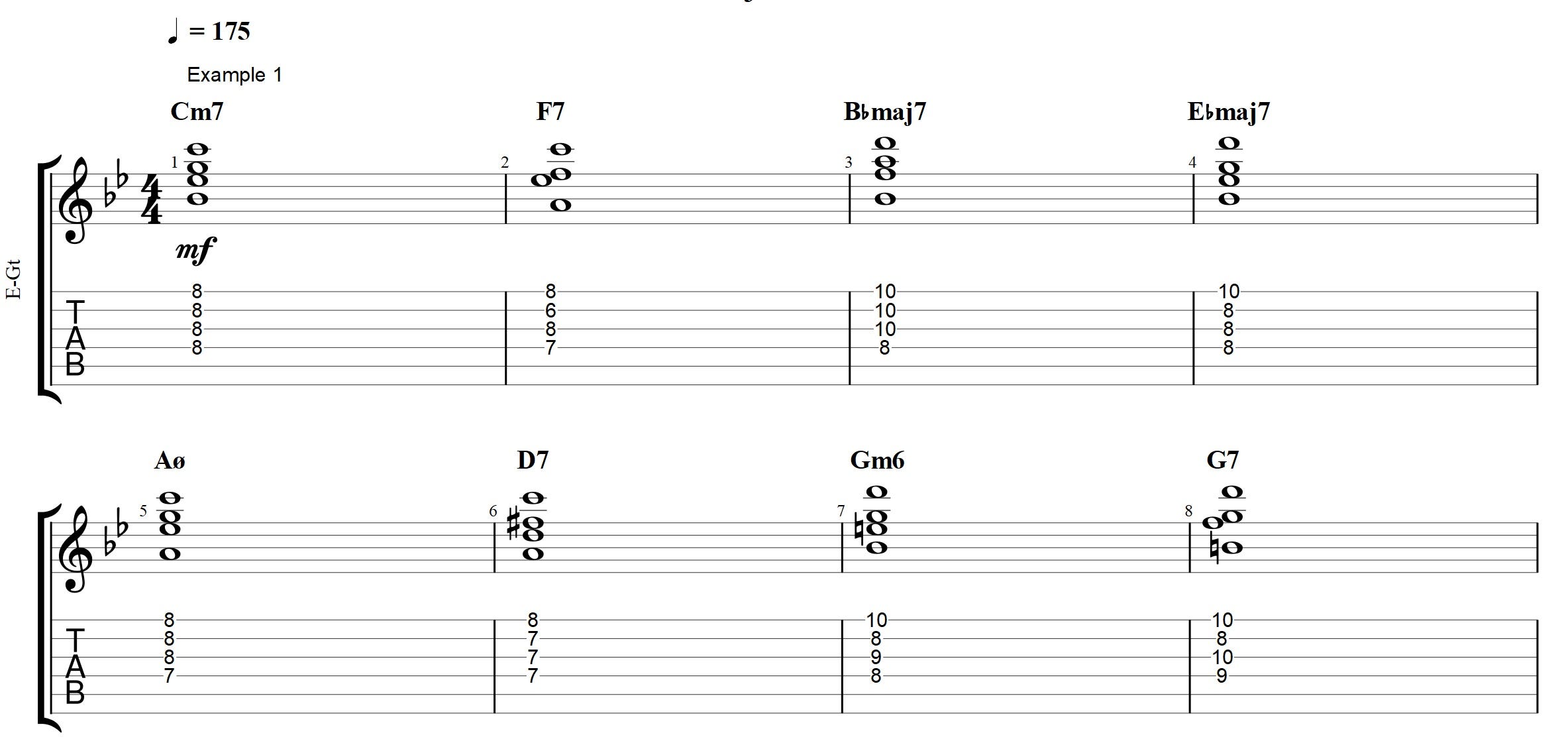- Autumn Leaves Chords Jazz Standard
- Autumn Leaves Chords Piano Pdf
- Autumn Leaves Chords Jazz
- Autumn Leaves Chords Ed
- Autumn Leaves Chords G Minor
3 Autumn Leaves Chord Progression Studies
Autumn Leaves Basic Chords TAB + visualisation, first eight bars in different voicings, starting with three note chords, then Drop3 /Drop2 mix.backing track.
Learning the Autumn Leaves chord progression is an important part of learning jazz guitar. Besides being one of the most commonly played standards at jam sessions, the Autumn Leaves chord progression is a great study for major and minor ii V I chords.
90% of the Autumn Leaves chord progression alternates between major and minor ii-V-I progressions.
The examples in this article only cover these two ii V I progressions. But you could play through each example twice and then play the minor ii V I followed by the major ii V I to get the B section which would give you three quarters of the Autumn Leaves chord progression.
- Autumn Leaves Eva Cassidy Am The falling Dm leaves G drift by my C win-dow Fmaj7 The falling Dm leaves E of red and Am gold.
- Learning the Autumn Leaves chord progression is an important part of learning jazz guitar. Besides being one of the most commonly played standards at jam sessions, the Autumn Leaves chord progression is a great study for major and minor ii V I chords. 90% of the Autumn Leaves chord progression alternates between major and minor ii-V-I progressions.
For a full and detailed analysis of Autumn Leaves, check out this in depth article that I published.
To play through each of these Autumn Leaves chord progression studies you will need to know the following techniques:
Having the Autumn Leaves chord progression memorized is also important.
Try playing through chords using whole notes rhythms at first and eventually quarter notes while humming or whistling the melody to memorize the chords.
Autumn Leaves Chords Jazz Standard
Many jazz standards modulate from the major to the relative minor and vice versa.
Because of this it is worth taking each of these studies into all 12 keys.
For further chordal study I recommend creating a melody arrangement using the chords from the Autumn Leaves chord progression.
Autumn Leaves Chord Progression
Autumn Leaves Chord Progression Study 1
As mentioned earlier, the first rhythm to explore when practicing the autumn leaves chord progression or any set of new chords is the whole note rhythm.
Practicing using whole note rhythms ensures that there is enough time to switch between each chord which is particularly useful if you are working on new jazz guitar chords.
Take note of the voice leading in each chord too. Rather than jumping across the fretboard, each of the chord moves to the nearest available chord which only requires moving a few frets.

This example uses drop 2 chord inversions for the minor 7th and major chords and dominant7b9 chords for the dominant 7ths.
Once you can fluently play this study, use the same chords on the same string set, but start with a different C-7 voicing.
Doing this will ensure that you cover all the possible inversions using drop 2 chords and dom7b9 chords on the top four strings.
You can also start with a C-7 higher up the neck and descend through inversions rather than ascend, like in this example.
Autumn Leaves Chord Progression Study 2
Learning to play walking bass lines is an important part of developing good comping skills. This next autumn leaves chord progression study demonstrates the comping with bass lines technique.
Drop 3 chord inversions are used in the last two bars to create movement and interest. Try to create your own bass lines starting in different areas of the neck that go in different directions.
Autumn Leaves Chord Progression Study 3
Here is an etude that features modern jazz guitar voicings to finish off this autumn leaves chord progression study.
The chords in this example are more advanced than the previous studies so they might require more practice to play proficiently if you are new to jazz guitar.
Most of the chords is in this example feature clusters which are two intervals that are close together usually resulting in a dissonant effect.
If modern jazz guitar comping is your thing and you want to expand on this example, try experiment with inverted quartal chords and sus9 chords.
I hope that you have enjoyed playing and working through each of these Autumn Leaves chord progression studies.
Check out this link to a FREE Autumn Leaves backing track without piano to practice these chords over.
What do you think of each of these studies? Share your thoughts in the comment section below.
Many of my student at all levels and benefiting and praising this new internet based software which allows them to see, hear, and play any song from the internet in any key and at a comfortable learning speed.
The song is in AABC form. 'Autumn Leaves' offers a popular way for beginning jazz musicians to become acquainted with jazz harmony as the chord progression consists almost solely of ii-V-I and ii-V sequences which are typical of jazz.

Autumn Leaves chords were originally, and are most commonly, performed in the key of E minor, but are also played in G minor and other keys.
I learned the Autumn Leaves Chords as a kid, maybe 15 or 16 years old. I think I had just broken up with my first girlfriend (or should I say she broke up with me) and the mood of the song captured what I was feeling as it is with many of our favorite songs.
Years later I was surprised that it turned up as a lesson in music school at Berklee College of music.
Just a few days ago I arranged a swing version on my arranger keyboard and though it would be a good idea to share it with you.
As stated above it is a great way to teach the 2-5-1 progression as well as piano improvisation.
Andy Williams released a version of the song on his 1959 album, Lonely Street.
The Coasters released a version of the song on their 1960 album One by One.
Al Hirt released a version on his 1965 album, They're Playing Our Song.
The British Invasion band Manfred Mann released a rock version on their 1966 album As Is.
Italian-American tenor Sergio Franchi recorded his version on the 1968 RCA Victor album I'm a Fool to Want You.
Raquel Bitton recorded a version in 2000 that appears on her album Raquel Bitton sings Edith Piaf.
Jerry Lee Lewis released a version that can be found on the 2000 album The Jerry Lee Lewis Show.
Autumn Leaves Chords structure

If you get comfortable with the chord progression for this song you will find parts of it turning up in lots of songs you will encounter in popular jazz music as well as other genres.
The song is most often played in the Key of E minor, the relative minor of G major thus you will notice the F# in the key signature.
For more on key signatures you would do well to study the circle of fifths.
Every Chord in the song is Diatonic to the Key of G (E minor) except for the B7 chord which functions as the V7 chord of E minor.

There are two lessons I would recommend to help you with your understanding of diatonic chords and some useful exercises that are guaranteed to have you moving through jazz chord changes easily.
Diatonic Chords and Common Chord Progressions
You will notice as you play through the changes that the root motion jumps up a fourth and down a fifth almost without exception.
This is one of the reasons that this tune is taught to beginning jazz students as this motion is very very common in Jazz.
Another reason for learning this tune is that it is just plain beautiful, easy to play and fun to solo over.
Contact me

If you have any questions, suggestions, or ideas for future lessons feel free to Contact Me.
The Best Home Study Course for Learning Jazz and Blues Piano
Autumn Leaves Chords Piano Pdf
Have you always wanted to learn to play jazz & blues on thepiano but never had the time or money?
Or couldn't find the right person or course to teach you the'real' stuff?
Autumn Leaves Chords Jazz
If so, I've definitely found someone who can help you.
I'm talking about James Wrubel, an amazing musician and expertinstructor. He's been there and back as a professional jazzmusician and has played with some of the top names in theindustry.
In two dvds and over 2 hours of step-by-step instruction, hetakes you by the hand and shows you how to master tons of jazz &blues tricks and techniques as well as signature soloing secretsthat'll have you sounding like you've been playing for years.
Here's some highlights.
Discover: * How to quickly and easily form tons of chord patterns and runs that'll have you sounding pro almost overnight.
* How to accelerate your jazz learning curve by combining 3 secret elements pros don't want you to know!
* How to pack every chord and voicing with just the right amount of flavor to get the job done.
Autumn Leaves Chords Ed
* 7 secrets to playing signature solos without hesitation or even thinking about anything.
Autumn Leaves Chords G Minor
* And much more.
Check out the ink below for more information on this great program
© Copyright piano-lessons-for-life.com
Solo Build It!